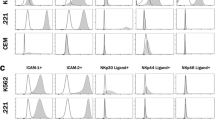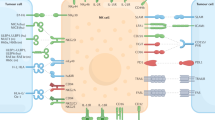Abstract
The central question of the nature of the structure(s) involved in the recognition of targets by natural killer (NK) cells remains unresolved. Although NK-mediated cytotoxicity is not MHC-restricted, it has been suggested that these cells could recognize the targets more effectively in the absence of MHC class I antigens. In this paper we review the contradictory results obtained when studying the NK susceptibility of cell lines which constitutively express different levels of MHC antigens, or which have been induced to express MHC antigens by gene transfection or gamma-interferon treatment. Taken together, the results indicate that MHC antigens play a differential role in NK lysis depending on the nature of the target cells used; MHC class I antigens play a role in the NK resistance of cells from a hematopoietic lineage, but this does not extend to cells from other origins. The data reviewed also support the hypothesis that MHC class I antigens induced NK resistance by interfering with target structures, and that multiple NK molecules are involved in NK-mediated lysis as part of a possible advanced recognition system.
Similar content being viewed by others
References
Chambers WH, Vujanovic LN, De Leo AB, Olszowy MW, Herberman RB, Hiserodt JC: Monoclonal antibody to a triggering structure expressed on rat natural killer cells and adherent lymphokine-activated killer cells. J Exp Med 1989;169: 1373–1383.
Harris DT, Jaso-Friedmann L, Devlin RB, Koren HS, Evans SL: Identification of a human natural killer cell target cell antigen with monoclonal antibodies. J Immunol 1989; 143:727–735.
Trinchieri G: Biology of natural killer cells. Adv Immunol 1989;47: 187–342.
Ortaldo JR, Hiserodt JC: Mechanisms of target cell killing by natural killer cells. Curr Opin Immunol 1990;2:39–44.
Karre K, Ljunggren JH, Piontek G, Kiessling F: Selective rejection of H-2 deficient lymphoma variants suggests alternative immune defense strategy. Nature 1986;319:675–678.
Karre K: Role of target histocompatibility antigens in regulation of natural killer activity: A reevaluation and a hypothesis, in Herberman RB, Callewaert D (eds): Mechanisms of Cytotoxicity by Natural Killer cells. Orlando, Academic Press, 1985, pp 81–85.
Piontek GE, Taniguchi K, Ljunggren H, Gromberg A, Kiessling R, Klein G, Karre K: YAC-1 MHC class I variants reveal an association between decreased NK sensitivity and increased H-2 expression after interferon treatment or in vivo passage. J Immunol 1985;135:4281–4288.
Algarra I, Ohlen C, Perez M, Ljünggren HG, Klein G, Garrido F, Karre K: MHC class I deficient cells within a heterogeneous fibrosarcoma show elevated NK sensitivity and reduced survival in the lungs after intravenous administration. Int J Cancer 1989;44:675–680.
Taniguchi K, Petersson M, Hoglund P, Kiessling R, Klein G, Karre K: Interferon γ induces lung colonization by intravenously inoculated B16 melanoma cells in parallel with enhanced expression of class I mayor histocompatibility complex antigens. Proc Natl Acad Sci (USA) 1987;84: 3405–3409.
Storkus WJ, Howell DN, Salter RD, Dawson JR, Cresswell P: NK susceptibility varies inversely with target cell class I HLA expression. J Immunol 1987;138:1657–1659.
Harel-Bellan A, Quillet A, Marchiol C, Demars R, Tursz T, Fradelizi D: Natural killer susceptibility of human cells may be regulated by genes in the HLA region of chromosome 6. Proc Natl Acad Sci (USA) 1986;8: 5688–5692.
Ohlën C, Bejarano MT, Grönberg A, Torsteinsdottir, S, Franksson L, Ljunggren HG, Klein E, Klein G, Kärre K: Studies of sublines selected for loss of HLA expression from an EBV-transformed lymphoblastoid cell line: Changes in sensitivity to cytotoxic T cells activated by allostimulation and natural killer cells activated by IFN or IL-2. J Immunol 1989;142:3336–3341.
Stam NJ, Kast WM, Voordouw AC, Pastoors LB, Van der Hoeven FA, Melief CJM, Ploegh HL: Lack of correlation between levels of MHC class I antigen and susceptibility to lysis of small cellular lung carcinoma by natural killer cells. J Immunol 1989;142:4113–4117.
de Fries R, Golub SH: Interferon reduces the sensitivity of cultured and fresh human tumor cells to lysis by lymphokine-activated killer cells. Nat Immun Cell Growth Regul 1988;7:65–76.
Alonso C, Serrano R, Solana R, Peña J: Natural killer susceptibility of brain tumor cell lines inversely correlates with the degree of cell differentiation. Int Arch Allergy Appl Immunol 1989;89:169–172.
Peña J, Solana R, Alonso C, Santamaría M, Serrano R, Ramirez R, Carracedo J: MHC class I expression on human tumor cells and their susceptibility to NK lysis. J Immunogenet 1989;16:407–412.
Peña J, Alonso C, Solana R, Serrano R, Carracedo J, Ramirez R: Natural killer susceptibility is independent of HLA class I antigen expression on cell lines obtained from human solid tumors. Eur J Immunol 1990;20: 2445–2449.
Lotzova E, Ades EW: Natural immune killer cells definition, heterogeneity, lytic mechanism, genetics and clinical application. Highlights of the fifth international workshop on NK cells. Nat Immun Cell Growth Regul 1989;8:1–7.
Ljunggren HG, Karre K: In search of the ‘missing self’: MHC molecules and NK cells recognition. Immunol Today 1990;11:237–244.
Solana R, Serrano R, Peña J: MHC antigens in NK recognition and lysis. Immunol Today 1991;12:95.
Nishimura M, Stroynowski I, Hodd L, Ostrand-Rosenberg S: H-2Kb antigen expression has no effect on natural killer susceptibility and tumorigenicity of a murine hepatoma. J Immunol 1988;141:4403–4409.
Dennert G, Landou C, Lord EM, Bahler DW, Frelinger JK: Lysis of a lung carcinoma by poly I-C-induced natural killer cells is independent of the expression of class I histocompatibility antigens. J Immunol 1988; 140:2472–2475.
Sturmhofel K, Hammerling G: Reconstitution of H-2 class I expression by gene transfection decreases susceptibility to natural killer cells of an EL4 class I loss variant. Eur J Immunol 1990;20:171–175.
Gorelik E, Gunji Y, Herberman R: H-2 antigen expression and sensitivity of BL6 melanoma cells to natural killer cell cytotoxicity. J Immunol 1988;140:2096–2101.
Quillet A, Presse F, Marchiol-Fournigault C, Harel-Bellan A, Benbunan M, Ploegh H, Fradelizi D: Increased resistance to non-MHC-restricted cytotoxicity related to HLA A, B expression. Direct demonstration using β2-microglobulin transfected Daudi cells. J Immunol 1988; 141:17–20.
Storkus WJ, Alexander J, Payne JA, Cresswell P, Dawson JR: The α1/α2 domains of class I HLA molecules confer resistance to natural killing. J Immunol 1989;143:3853–3857.
Storkus WJ, Alexander J, Payne AJ, Dawson JR, Cresswell P: Reversal of natural killing susceptibility in target cells expressing transfected HLA class I genes. Proc Natl Acad Sci (USA) 1989;86:2361–2364.
Shimizu Y, Demars R: Demonstration by class I gene transfer that reduced susceptibility of human cells to natural killer cell-mediated lysis is inversely correlated with HLA class I antigen expression. Eur J Immunol 1989;19:447–451.
Leiden JM, Kornbluth J: Susceptibility to natural killer cell mediated cytolysis is independent of the level of target cell class I HLA expression; in Ades EW, Lopez C (eds): Natural Killer Cells and Host Defense, 5th Int NK Cells Workshop. Basel, Karger, pp 198–206.
Storkus WJ, Salter RD, Alexander J, Ward FE, Ruiz RE, Creswell P, Dawson JR: Class I induced resistance to natural killing: Identification of nonpermissive residues in HLA-A2. Proc Natl Acad Sci (USA) 1991;88:5989–5992.
Woodroofe MN, Hayes GM, Cuzner L: Fc receptor density, MHC antigen expression and superoxide production are increased in interferon gamma treated microglia isolated from adult rat brain. Immunology 1989;68:421–425.
Giuliani-Bonmassar A, Graziani L, Frati L, Bonmassar E: Inverferon-induced changes in the susceptibility of murine and human lymphoma cells to natural cytotoxic lymphocytes. Int J Tissue React 1984;6:35–42.
Moore W, White M, Potter MR: Modulation of target cell susceptibility to human natural killer cells by interferon. Int J Cancer 1980;25: 565–570.
Trinchieri G, Santoli D: Antiviral activity induced by culturing lymphocytes with tumor-derived or virus-transformed cells. Enhancement of human natural killer cell activity by interferon and antagonistic inhibition of susceptibility of target cells to lysis. J Exp Med 1978;147:1314–1321.
Welsh RM, Karre K, Hansson M, Kunker LA, Kiessling RW: Interferon-mediated protection of normal and tumor target cells against lysis by mouse natural killer cells. J Immunol 1981;126:219–224.
Witte T, Wordelmann K, Schmidt RE: Heterogeneity of human natural killer cells in the spleen. Immunology 1990;69:166–172.
Gronberg A, Kiessling R, Masucci G, Guevara LA, Eriksson E, Klein G: Gamma-IFN (IFN-γ) produced during effector and target interactions renders target cells less susceptible to NK-cell-mediated lysis. Int J Cancer 1983;32:609–615.
Gronberg A, Ferm MT, Reynolds CW, Ortaldo JR: IFN-gamma treatment of K562 cells inhibits natural killer cell triggering and decreases the susceptibility to lysis by cytoplasmic granules from large granular lymphocytes. J Immunol 1988;14: 4397–4402.
Powell J, Stone J, Chan VC, Yang Z, Leatherbury A, Sell KW, Wiktor-Jedrzejczak W, Ahmed-Ansari A: Interferon-gamma-treated K562 target cells distinguish functional NK cells from lymphokine-activated killer (LAK) cells. Cell Immunol 1989;118:250–259.
Uchida A, Vanky F, Klein E: Natural cytotoxicity of human blood lymphocytes and monocytes and their cytotoxic factors: Effect of interferon in target cell susceptibility. J Natl Cancer Inst 1985;75:849–854.
Wright SC, Bonavida B: Studies on the mechanism of natural killer cell-mediated cytotoxicity. IV. Interferon induced inhibition of NK target cell susceptibility to lysis is due to a defect in their ability to stimulate release of natural killer cytotoxic factors (NKCF). J Immunol 1983;130:2965–2972.
Ramirez R, Solana R, Carracedo J, Alonso MC, Peña J: Mechanisms involved in NK resistance induced by interferon-γ. Cell Immunol 1992; 140:248–256.
Serrano R, Alonso C, Solana R, Monserrat J, Muñoz J, Peña J: Identification of a tumor factor inducing resistance to NK cell lysis. Immunol Lett 1989;20:311–316.
Solana R, Alonso C, Ramirez R, Carracedo J, Serrano R, Yiangou Y, Peña J: Analysis of the mechanisms involved in NK resistance induced by a new tumor factor NK-RIF. Cell Immunol 1990;130:244–251.
Serrano R, Yiangou Y, Solana R, Sachs JA, Peña J: Isolation of a novel tumor protein that induces resistance to natural killer cell lysis. J Immunol 1990;145:3516–3523.
Moretta A, Tambussi G, Bottino C, Tripodi G, Merli A, Cioccone E, Pantalco G, Moretta L: A novel surface antigen expressed by a subset of human CD3− CD16+ natural killer cells. Role in cell activation and regulation of cytolytic function. J Exp Med 1990;171:695–714.
Herberman RB, Reynolds CW, Ortaldo JR: Mechanism of cytotoxicity by natural killer cells. Annu Rev Immunol 1986;4:651–670.
Savary CA, Lotzova E: Phylogeny and ontogeny of NK cells; in Lotzova E, Herberman RB (eds). Immunology of Natural Killer Cells. Boca Raton. CRC Press, pp 46–52.
Author information
Authors and Affiliations
Rights and permissions
About this article
Cite this article
Peña, J., Solana, R. Histocompatibility antigens and natural killer susceptibility. Immunol Res 11, 133–140 (1992). https://doi.org/10.1007/BF02918618
Issue Date:
DOI: https://doi.org/10.1007/BF02918618




